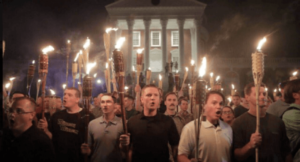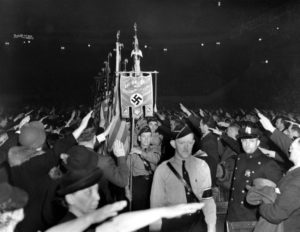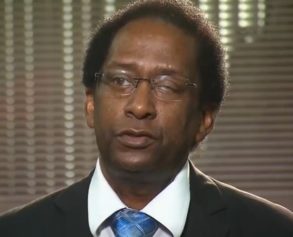
“Unite the Right” marchers showed up in Charlottesville, Va., this past weekend by the hundreds to rally in support of various causes unified by themes of white supremacy. Source: Twitter
Finally, America has discovered white supremacy. The recent “Unite the Right” rally in Charlottesville, Virginia was a gathering of alt-right, neo-Nazis, Klan and other extremists, but also more mainstream college Republicans, rightwing activists and intellectuals, and more casual racists and aggrieved white people who hope to distinguish themselves from the old-school organizations such as the KKK. Unite the Right was an orchestrated race riot that resulted in the death of one woman and many others injured. This is expected to be just one of a series of white supremacist actions taking place across the nation in the coming days. While many people are only now acknowledging white Christian domestic terrorism is an issue in America, Black people have lived under this terror — the lynchings, the intimidation, the trauma — for hundreds of years. After all, Black people have been dealing with the Ku Klux Klan for decades before they were renamed and rebranded as the alt-right.
The Ku Klux Klan is the oldest and most notorious hate group in the United States. Formed in 1865 after the Civil War by Confederate veterans, the Klan was a vigilante group designed to intimidate Black people and restore white supremacy to the South. The group waged a campaign of violence against Republican elected officials, both Black and white. Another group, the Red Shirts of South Carolina, was a paramilitary organization using rifles and pistols to intimidate Black and Republican voters. “Lynchings, tar-and-featherings, rapes and other violent attacks on those challenging white supremacy became a hallmark of the Klan,” according to the Southern Poverty Law Center. With the end of Reconstruction and the withdrawal of the federal troops from the South came the reestablishment of white power by the Democrats, and the rise of the Jim Crow segregation regime.
After a decline, the Klan was resurrected with the infamous D.W. Griffith film The Birth of a Nation, which glorified the white terror organization as heroes. In 1915 — over a century before Trump was accused of buoying the white supremacist movement — President Woodrow Wilson screened the film at the White House and after viewing it, said: “It is like writing history with lightning, and my only regret is that it is all so terribly true.” The KKK experienced a resurgence in the early 20th century, with political power in state houses and on Capitol Hill, and 4 million members at its peak in 1925, when the group held its massive march on Washington.

Ku Klux Klan members hold a march in Washington, D.C., on Aug. 9, 1925.
Bettmann/Corbis
On Memorial Day 1927, President Trump’s father, Fred Trump was arrested at riot of 1,000 white-robed Klansmen and 100 police officers in the New York City neighborhood of Jamaica, Queens. The elder Trump’s role in the brawl is uncertain, and Donald Trump denies the incident ever happened.
The power and influence of the Klan waned as a result of the Great Depression, sex scandals, internal power struggles and increased media exposure of its internal workings. The Klan had another reboot in the 1960s, when it resisted the civil rights movement and fought to maintain Jim Crow segregation following the 1955 U.S. Supreme Court decision in Brown v. Board of Education. The 1963 murder of four little girls in the bombing of the 16th Street Baptist Church in Birmingham, Alabama, the assassination of Medgar Evers, and the lynching of civil rights workers in Mississippi are but a few examples of the Klan’s handiwork during that time. Often, the KKK and law enforcement were one and the same, as if to mirror the terror visited upon Black people when they first encountered policing on the slave plantation.
A Klan terror attack that bears similarities to recent events in Charlottesville was the Greensboro Massacre of 1979. During a “Death to the Klan” rally held by members of the Worker Viewpoint Organization (later known as the Communist Workers Party) at Morningside Home, a Black housing project, members of the KKK and the American Nazi Party converged on the rally in a caravan, armed with guns and sticks, and killing five and wounding nearly a dozen more.
Greensboro Massacre 1979 from Daniel Spiller on Vimeo.

Nazi rally at New York’s Madison Square Garden, Feb. 20, 1939 (AP).
Nazis are another group with a long history in the United States. In the 1930s, American Nazis enjoyed membership in the tens of thousands. In 1936, the German American Bund was formed as “an organization of patriotic Americans of German stock,” with 20 youth and training camps, and 70 regional divisions across America. On February 20, 1939, the Bund held an “Americanization” rally in New York’s Madison Square Garden, in which over 20,000 people attended. The advent of World War II with Germany’s invasion of Poland on Sept. 1, 1939, began the suppression of the Bund, and the United States’ latter entry in the war would effectively finish off American groups who were overtly sympathetic to German Chancellor Adolf Hitler’s Third Reich.
The legacy of domestic terrorism and racial violence has taken an enormous toll on Black people. A report from the Equal Justice Initiative documented 4,075 lynchings of Black people that took place in Alabama, Arkansas, Florida, Georgia, Kentucky, Louisiana, Mississippi, North Carolina, South Carolina, Tennessee, Texas and Virginia between 1877 and 1950. Many additional lynchings took place in other states as well. White terrorists and armed mobs killed hundreds of Black people in acts of racial cleansing such as the Slocum Massacre of 1910, and the Tulsa Race Riot of 1921, in which a white mob destroyed nearly all of the homes and businesses in the Black community of Greenwood, known as Black Wall Street. For the perennial victims of white supremacist violence, the domestic terrorists never abated. In fact, these hate groups are on the rise and proliferating. America is a country long in denial about its history of racial violence and the exploitation of racial resentment, a legacy of oppression that many do not learn in school, as people grow up believing the Civil War was fought over economics. Many are now discovering the harsh reality that Black people have known and endured for generations.


